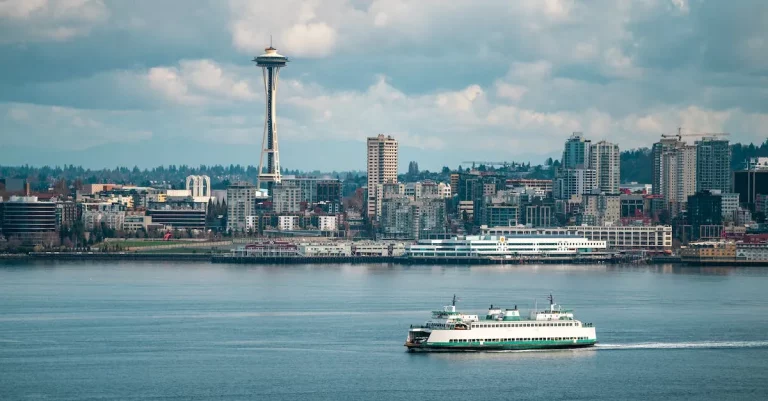What Tectonic Plate Is Los Angeles Located On?
The Earth’s surface is broken up into giant slabs called tectonic plates, which fit together like a jigsaw puzzle. Their movements cause major geological events like earthquakes and volcanic eruptions. So what plate sits under the city of Los Angeles?
If you’re short on time, here’s a quick answer to your question: Los Angeles is located on the Pacific Plate, which extends under the Pacific Ocean basin and along much of the North American West Coast and Alaska.
In this article, we’ll explore details including:
The boundaries and movement of the Pacific Plate, How plate tectonics impact Los Angeles, Other major faults and plates in the region, The history of quakes in LA and future risks, How plate knowledge informs earthquake prep.
The Pacific Plate and its Boundaries
Plate Overview
Los Angeles is located on the tectonic plate known as the Pacific Plate. The Pacific Plate is one of the largest and most active tectonic plates on Earth. It covers a vast area, stretching from the western coast of North America to the eastern coast of Asia.
The plate is named after the Pacific Ocean, which lies to its west.
The Pacific Plate is classified as an oceanic plate, meaning it is primarily composed of dense oceanic crust. It is bordered by several other tectonic plates, including the North American Plate, the Philippine Sea Plate, and the Juan de Fuca Plate.
These plates form the intricate network of boundaries that shape the geology and seismic activity of the region.
Movement and Boundaries
The Pacific Plate is constantly in motion, moving in a northwestern direction at a rate of approximately 3 inches (8 centimeters) per year. This movement is driven by the convective currents within the Earth’s mantle.
The boundaries of the Pacific Plate are characterized by intense geological activity. One of the most well-known boundaries is the San Andreas Fault, which marks the boundary between the Pacific Plate and the North American Plate.
This fault is responsible for many earthquakes and is a significant factor in shaping the landscape of California.
Additionally, the Pacific Plate is involved in subduction zones, where it meets other plates. Subduction occurs when one tectonic plate is forced beneath another plate, creating areas of intense volcanic activity.
The Pacific Plate is involved in subduction along the western coast of North America, leading to the formation of the Cascade Range and the volcanic activity in the region.
Understanding the Pacific Plate and its boundaries is crucial for studying and predicting seismic activity in the Los Angeles area. By monitoring the movement and interactions of these tectonic plates, scientists can better prepare for potential earthquakes and mitigate the risks associated with living in an active seismic zone.
Plate Tectonics and Their Impact on Los Angeles
Los Angeles, the second most populous city in the United States, is located in a region that is highly susceptible to seismic activity due to its position on the Pacific Ring of Fire. This area is characterized by the interaction of several tectonic plates, which are large pieces of the Earth’s lithosphere that float on the semi-fluid asthenosphere beneath them.
Fault Lines in the Region
One of the major fault lines in the region is the San Andreas Fault, which runs through California for approximately 800 miles. This fault is responsible for the frequent earthquakes experienced in the area.
The San Andreas Fault is a transform boundary where the Pacific Plate and the North American Plate are sliding past each other horizontally. The movement along this fault can cause significant seismic activity, as well as potential for major earthquakes.
Another notable fault line in the area is the Puente Hills Fault, which runs beneath the Los Angeles Basin. This fault is considered particularly dangerous due to its proximity to densely populated areas.
The potential for a major earthquake along this fault poses significant risks to the city and its infrastructure.
Frequency of Earthquakes
Los Angeles experiences earthquakes on a regular basis due to its location on active fault lines. While most earthquakes are relatively minor and go unnoticed by residents, larger events can cause significant damage.
The frequency of earthquakes in the region serves as a reminder of the constant geological activity occurring beneath the surface.
According to the United States Geological Survey (USGS), there were over 10,000 earthquakes recorded in California in 2020, with the majority occurring in the southern part of the state. While not all of these earthquakes were felt by residents, they highlight the active nature of the region.
Risks and Damage
The seismic activity in Los Angeles poses various risks and potential damage to the city and its residents. Major earthquakes can result in the collapse of buildings, infrastructure damage, and the disruption of essential services such as water and electricity.
The threat of landslides and tsunamis in coastal areas further adds to the potential risks.
Despite these risks, Los Angeles has implemented strict building codes and regulations to ensure structures can withstand earthquakes to a certain extent. However, the sheer size and population density of the city means that the potential for damage and loss of life in the event of a major earthquake remains a concern.
It is important for residents of Los Angeles and the surrounding areas to be prepared and educated about earthquake safety measures, including having emergency kits, knowing evacuation routes, and understanding the appropriate actions to take during and after an earthquake.
For more information on earthquake preparedness and the latest seismic activity in the region, visit the United States Geological Survey (USGS) website.
Other Major Faults and Plates in the LA Region
Aside from the well-known San Andreas Fault, there are several other major faults and tectonic plates that play a significant role in the geology of the Los Angeles (LA) region. These faults and plates contribute to the seismic activity that the area experiences and have a direct impact on the city’s infrastructure and safety measures.
San Andreas Fault
The San Andreas Fault is undoubtedly the most infamous fault in the LA region. It stretches roughly 800 miles through California and is responsible for many of the earthquakes experienced in the state. This fault marks the boundary between the Pacific Plate and the North American Plate.
The movement of these two plates horizontally and in opposite directions is what causes the earthquakes along the fault line. The San Andreas Fault has the potential to produce a major earthquake, and scientists closely monitor it to assess the risk it poses to populated areas like Los Angeles.
Hayward Fault
Although the Hayward Fault is not located in the immediate vicinity of Los Angeles, it is worth mentioning due to its significance in the overall tectonic activity of California. This fault runs through the eastern side of the San Francisco Bay Area and is capable of producing large earthquakes.
It marks the boundary between the Pacific Plate and the North American Plate, similar to the San Andreas Fault. The Hayward Fault is estimated to have a 27% chance of experiencing a magnitude 6.7 or larger earthquake within the next 30 years, making it a concern for the entire state.
North American Plate
The North American Plate is the tectonic plate on which Los Angeles is primarily located. It is one of the largest plates on Earth and extends across most of North America. The North American Plate is bounded by several other major plates, including the Pacific Plate to the west and the Juan de Fuca Plate to the northwest.
These plate boundaries create a complex network of faults and contribute to the seismic activity in the region.
Understanding the various faults and tectonic plates in the LA region is crucial for earthquake preparedness and urban planning. By studying these geological features, scientists can better predict and mitigate the potential risks associated with seismic events.
It is important for residents and local authorities to stay informed and take necessary precautions to ensure the safety and resilience of the city.
History of Earthquakes and Future Risks for LA
Notable Quakes in LA’s Past
Los Angeles, located on the west coast of the United States, is situated on the Pacific Tectonic Plate. Over the years, the city has experienced several significant earthquakes due to the movement and interaction of tectonic plates.
One of the most notable earthquakes in LA’s history is the 1994 Northridge earthquake, which measured a magnitude of 6.7. This earthquake resulted in extensive damage to infrastructure and caused the loss of 57 lives.
Another memorable earthquake was the 1933 Long Beach earthquake, measuring a magnitude of 6.4, which caused substantial destruction and claimed the lives of 115 people.
These past earthquakes serve as a reminder of the seismic activity in the region and the potential risks that Los Angeles faces in the future.
Projecting Future Quake Patterns
Scientists and geologists have been studying the seismic activity in Los Angeles to better understand the patterns and predict future earthquakes. Through the use of advanced technology and data analysis, they have been able to identify areas of higher risk.
One study conducted by the Southern California Earthquake Center projected that there is a 99.7% chance of a magnitude 6.7 or larger earthquake occurring in the Los Angeles area within the next 30 years.
This highlights the importance of earthquake preparedness and taking necessary precautions to mitigate potential damage and loss of life.
Ongoing Threats and Preparedness
Despite the advancements in earthquake prediction and preparedness, Los Angeles continues to face ongoing threats from earthquakes. The city is located near the San Andreas Fault, one of the most active fault lines in the world.
To mitigate the risks, the city has implemented strict building codes and regulations to ensure that structures are built to withstand seismic activity. Additionally, public education and awareness campaigns have been launched to educate residents on earthquake preparedness, including creating emergency kits, establishing communication plans, and knowing the proper actions to take during an earthquake.
It is crucial for residents of Los Angeles and surrounding areas to stay informed about the potential risks of earthquakes and to take proactive measures to protect themselves and their communities. By being prepared and informed, individuals can help minimize the impact of future earthquakes and ensure the safety of themselves and their loved ones.
How Plate Knowledge Informs Earthquake Preparedness
Living in an earthquake-prone region like Los Angeles requires a comprehensive understanding of tectonic plates and their movements. By knowing the specific tectonic plate on which the city is located, experts can better prepare for potential seismic events.
This knowledge forms the basis of earthquake preparedness strategies and helps in improving building design, enhancing emergency response, and educating the public.
Improving Building Design
One of the key ways plate knowledge informs earthquake preparedness is through the improvement of building design. Architects and engineers take into account the specific characteristics of the tectonic plate Los Angeles sits on to construct structures that can withstand seismic activity.
For example, the city is located on the Pacific Plate, which is responsible for the infamous San Andreas Fault. Buildings in Los Angeles are designed to withstand the lateral forces generated by the Pacific Plate’s movement, ensuring the safety of residents and reducing potential damage during an earthquake.
Enhancing Emergency Response
Plate knowledge also plays a vital role in enhancing emergency response efforts. Understanding the tectonic plate Los Angeles is situated on allows emergency responders to anticipate the potential magnitude and impact of an earthquake.
This information helps in formulating effective response strategies, including the allocation of resources and personnel in high-risk areas. By having a clear understanding of the specific plate dynamics, emergency response teams can work efficiently to mitigate the effects of an earthquake and ensure the safety and well-being of the community.
Educating the Public
Public education is a crucial aspect of earthquake preparedness, and plate knowledge forms the foundation for informing and educating the public. By understanding the tectonic plate Los Angeles is located on, residents can better comprehend the risks they face and take necessary precautions.
Public education campaigns can provide information on earthquake safety measures, such as creating emergency kits, developing evacuation plans, and securing heavy furniture and fixtures. By disseminating accurate and up-to-date information about tectonic plates and their impact, the public can become more resilient and prepared in the event of an earthquake.
Conclusion
Los Angeles sits squarely on the Pacific Plate, which means it will remain vulnerable to major earthquakes from local faults. Understanding the tectonic forces at work empowers communities to improve structures, response plans, and education for facing future quakes.
While the seismic risks will continue, knowledge of LA’s plate geography allows the region to take proactive steps to maximize preparedness and resilience when the ground starts shaking.








